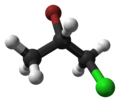| |||

| |||
| Names | |||
|---|---|---|---|
| Preferred IUPAC name
2-Bromo-1-chloropropane[1] | |||
| Identifiers | |||
3D model (JSmol)
|
|||
| ChEMBL | |||
| ChemSpider | |||
| ECHA InfoCard | 100.019.235 | ||
| EC Number |
| ||
PubChem CID
|
|||
| UNII | |||
CompTox Dashboard (EPA)
|
|||
| |||
| |||
| Properties | |||
| C3H6BrCl | |||
| Molar mass | 157.44 g·mol−1 | ||
| Appearance | Colourless liquid | ||
| Density | 1.537 g mL−1 | ||
| Boiling point | 116.6 °C; 241.8 °F; 389.7 K | ||
| log P | 2.262 | ||
Refractive index (nD)
|
1.4783 | ||
| Hazards | |||
| GHS labelling: | |||

| |||
| Warning | |||
| H302, H312, H315, H319, H332, H335 | |||
| P261, P280, P305+P351+P338 | |||
| Flash point | 113 °C (235 °F; 386 K) | ||
| Related compounds | |||
Related alkanes
|
Isobutyl chloride | ||
Related compounds
|
2-Chloroethanol | ||
Except where otherwise noted, data are given for materials in their standard state (at 25 °C [77 °F], 100 kPa).
| |||
2-Bromo-1-chloropropane, C3H6BrCl, is an alkyl halide. This simple compound has a chiral center and is used sometimes to determine the enantiomeric resolution of simple chromatographic methods.
- ^ "2-BROMO-1-CHLOROPROPANE - Compound Summary". PubChem Compound. USA: National Center for Biotechnology Information. 26 March 2005. Identification. Retrieved 25 June 2012.

